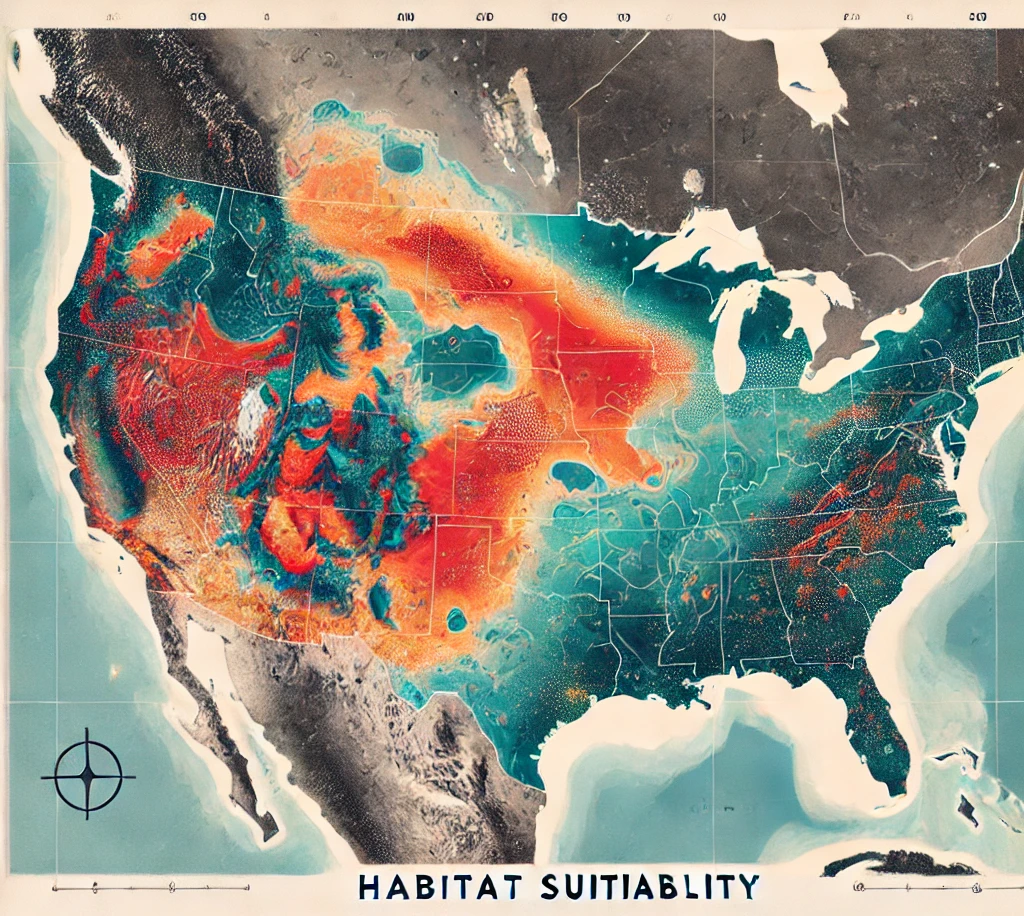| LM | SDM basics |
Obviously, there are too many species on Earth to know them all, not to say their distributional ranges. To make things even more complicated, a species does not exists physically but consists of individuals, which share characteristics according to a species concept.
This problem is known as the Wallacean shortfall and the reason why we need SDM: we never can sample all individuals of a species (some exeptions of extremely rare species may exist, though) to know the actual distribution of a species, not to mention their dynamics through time.

Image: Image generated by ChatGPT (OpenAI).
What is Species Distribution Modeling?
Species Distribution Modeling (SDM) is a methodology used to estimate and predict the geographic distribution of species by upscaling known occurrence records with environmental variables, such as temperature, precipitation, soil type, or land cover. SDM goes by several other names, which are also used synonymously, including Ecological Niche Modeling (ENM), Habitat Suitability Modeling (HSM), Bioclimatic Envelope Modeling (BEM), and Environmental Niche Modeling (Elith and Leathwick, 2009). However, some researchers make a clear distinction between the different terminologies: see for example the study by Peterson and Soberón, 2012 on “Species Distribution Modeling and Ecological Niche Modeling: Getting the Concepts Right”. For this course we will stick with the term SDM.
Biodiversity loss
Biodiversity, the variety of life on Earth, underpins the functioning of ecosystems and human well-being. It encompasses diversity within species, diversity between species, genetic diversity, or diversity of ecosystems. This diversity is not only intrinsic to the functioning of natural systems but also provides essential ecosystem services that are invaluable for human survival. Therefore, biodiversity forms the foundation of ecosystems that support our life on Earth.
Stable biodiversity increases the resilience to environmental changes, such as climate change, ensuring that ecosystems can adapt to disruptions. Next to the climate crisis the biodiversity crisis is one of the biggest crises facing humanity (Stephen et al. 2015). When we are talking about the biodiversity crisis we refer to the accelerated loss of species and habitats driven by human activities. Current extinction rates could even indicate that we could approach the sixth mass extinction on Earth (Barnosky et al. 2011)).
Habitat destruction, including deforestation, urbanization, and agricultural expansion, is a primary driver of biodiversity loss, as it reduces the available space for species, often leading to population declines and extinction (Scanes 2018, Brooks et al. 2002). Additionally ecosystems can be threatened by invasive species that outcompete native species for resources, disrupt ecological balances, and drive native species to extinction.
The impacts of biodiversity loss are far-reaching. It weakens ecosystem stability and reduces the services ecosystems provide. However, it can also be measured for industries that are particularly dependent on natural resources, such as agriculture, forestry, and fisheries, where significant economic losses are expected with the decline of biodiversity (Boyles et al 2011).
Addressing this biodiversity crisis requires coordinated conservation and restoration efforts. Protecting endangered species, restoring degraded ecosystems, monitoring of invasive species, and establishing protected areas and wildlife corridors are critical steps toward mitigating this crisis.
Why do we need Species Distribution Modeling?
SDM can play a crucial role in addressing the above-mentioned challenges by providing essential information to stakeholders and policymakers. Establishing protected areas or conservation programs for endangered species requires detailed knowledge of species distribution. To obtain this information, species experts conduct field surveys to determine the presence of individuals in specific areas of interest. However, these surveys are time-consuming, costly, and cover only limited areas. Most conservation efforts, however, require comprehensive data to inform decision-making. Such extensive data can be generated using SDM.
Application in nature conservation
Species distribution modeling is a topic that is not only highly relevant to research but also well established in conservation practice. In Germany, numerous projects at both the federal and state levels utilize SDM. You can check out a small collection of examples here:
Windkraftsensible Arten in Hessen
As SDM is already widely used for nature conservation, it is of utmost importance to develop high-quality models. In this course, we will explore this topic in depth, assessing whether existing species distribution models are truly fit for their intended purposes and identifying ways to address any deficiencies we encounter.
